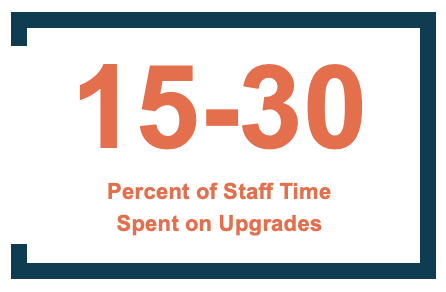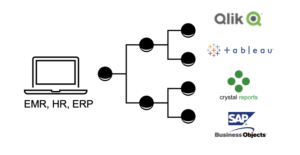For the past several years, Epic has been moving their customers to a quarterly or bi-annual upgrade. This is a net positive for customers since you’ll receive all the latest and greatest features which will get into the hands of providers and staff more rapidly than the traditional upgrade cycles of every 12-36 months.
There are drawbacks, however, that can drastically reduce the productivity of your team, with the primary one being reporting. Let’s dive into what problems this causes for reporting, and how our customers are solving those challenges.
During an upgrade, Epic releases new functionality to customers. This includes updates to workflows, administrative tools, provider happiness features, as well as changes to the backend data structures. All of these changes are meticulously documented in release notes for customers to review. The release notes highlight the key changes, inform you of it is an automatic change or one that requires configuration, provides detailed technical information, and more.
The good news is that for front-end changes many are either automatic or automatically ‘on’ unless turned off. This makes application analyst jobs easier and usually only requires a tip sheet for clinical/administrative users.
Backend database changes are more involved. Not because you have to change any major configuration, but because of the downstream impacts. The data generated are not used only by Epic. They’re used by 3rd party reporting tools, queried for regulatory submission, transmitted to EDWs, sent to HIEs, and more.
The backend change of an Epic upgrade impacts all of those data use cases. To ensure these mission critical data pipelines are not ruptured upon upgrade, your analysts need to:
 On average, our customers are spending more than 30 days finding fields and analyzing impact of a given upgrade and communicating with stakeholders regarding the update. And this isn’t just one person spending time on this. It’s people from every Epic application team and your business intelligence teams and your IT staff supporting data pipelines and staff managing regulatory reporting. Hundreds of people are losing productivity for approximately 15-30% of the year depending on how often you upgrade.
On average, our customers are spending more than 30 days finding fields and analyzing impact of a given upgrade and communicating with stakeholders regarding the update. And this isn’t just one person spending time on this. It’s people from every Epic application team and your business intelligence teams and your IT staff supporting data pipelines and staff managing regulatory reporting. Hundreds of people are losing productivity for approximately 15-30% of the year depending on how often you upgrade.
Prominence partnered with a customer and Informatica to implement an Enterprise Data Catalog that reduces the time spent searching for fields and analyzing impact approximately 3 minutes. It does this by automatically scanning your databases, ETL pipelines, and data visualization tools to create a searchable catalog.

Now, upon reviewing release notes, analysts simply type in the name of the impacted field into the search box of the Enterprise Data Catalog and are presented with every data extraction, transformation, model, and visualization that needs to be updated. No manual effort required to capture every place those impacted fields are used.
The search results are presented in both tabular and visual format, allowing you view and consume the lineage data as it makes sense for you and your colleagues. Best of all, these results can be shared with stakeholders and other developers, virtually eliminating the time spent on gaining consensus for the necessary course of action and communication.
This ensures your team is able to stay focused on mission-critical data needs instead of losing months of productivity during each and every upgrade. And with Epic moving people to bi-annual and quarterly upgrades this can mean the difference between achieving major organizational goals, implementing provider satisfying features that reduce burnout, or updating workflows to ensure they’re as streamlined as possible.
The Enterprise Data Catalog isn’t limited to use during upgrades or just Epic data sources. It can also scan your other data sources, such as ERP, HR, Time & Attendance, Payroll & Benefits, Credentialing, Quality and more, to further automate upgrade processes across all of your major systems.
Our customers are also using the Enterprise Data Catalog rapidly verify that their thousands of consumer-facing reports are using the correct data elements. Instead of manually reviewing each report, you can view lineage for every report to verify it is using the correct field and identify those that aren’t for rapid remediation.
Implementing an Enterprise Data Catalog is a game changing initiative for any healthcare organization and can be completed in just a few weeks. It maximizes your investments in staff and tools by automating labor-intensive and error prone tasks so you can focus on what matters most: making your providers more effective, keeping your patients healthy, and driving satisfaction.
 Access the one-page case study that you can use to socialize the power of an Enterprise Data Catalog throughout your organization. It offers an overview of the project and conservative ROI estimates. Additionally, if you’d like to be notified when we release a recorded demo of the solution then let us know here!
Access the one-page case study that you can use to socialize the power of an Enterprise Data Catalog throughout your organization. It offers an overview of the project and conservative ROI estimates. Additionally, if you’d like to be notified when we release a recorded demo of the solution then let us know here!
Lastly, our team of experts would be happy to provide a no-strings conversation about how an Enterprise Data Catalog would specifically benefit your organization. This includes a live demonstration and an opportunity for Q&A from your team. As always, it’s a no-pressure conversation where you can draw from our experience with 90+ healthcare organizations across the nation.
If this blog post missed the mark or you’d like additional content or detail in future posts, just let us know. Our goal is to provide useful, actionable information to help healthcare organizations do more with their data and make healthcare smarter.